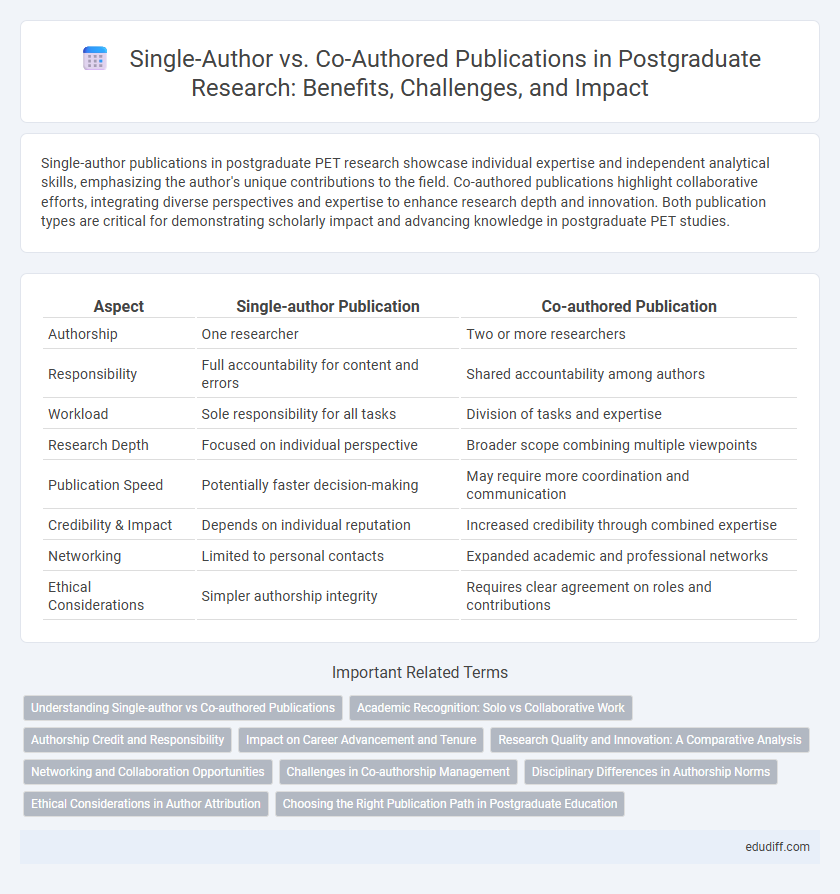Single-author publications in postgraduate PET research showcase individual expertise and independent analytical skills, emphasizing the author's unique contributions to the field. Co-authored publications highlight collaborative efforts, integrating diverse perspectives and expertise to enhance research depth and innovation. Both publication types are critical for demonstrating scholarly impact and advancing knowledge in postgraduate PET studies.
Table of Comparison
| Aspect | Single-author Publication | Co-authored Publication |
|---|---|---|
| Authorship | One researcher | Two or more researchers |
| Responsibility | Full accountability for content and errors | Shared accountability among authors |
| Workload | Sole responsibility for all tasks | Division of tasks and expertise |
| Research Depth | Focused on individual perspective | Broader scope combining multiple viewpoints |
| Publication Speed | Potentially faster decision-making | May require more coordination and communication |
| Credibility & Impact | Depends on individual reputation | Increased credibility through combined expertise |
| Networking | Limited to personal contacts | Expanded academic and professional networks |
| Ethical Considerations | Simpler authorship integrity | Requires clear agreement on roles and contributions |
Understanding Single-author vs Co-authored Publications
Single-author publications showcase an individual's independent research capabilities and original contributions to their academic field, enhancing personal credibility and expertise. Co-authored publications reflect collaborative efforts, combining diverse knowledge and skills which often lead to higher citation rates and broader research impact. Understanding these distinctions helps postgraduate researchers strategically plan their publication portfolio to balance personal recognition with collaborative influence.
Academic Recognition: Solo vs Collaborative Work
Single-author publications often highlight an individual's expertise and independent contribution, enhancing personal academic recognition and career advancement. Co-authored publications emphasize collaborative skills, interdisciplinary perspectives, and the ability to work in research teams, which are increasingly valued in academia. Academic institutions and funding bodies recognize both solo and collaborative works, with balanced evaluation criteria reflecting the evolving nature of research and knowledge production.
Authorship Credit and Responsibility
Single-author publications grant full authorship credit and sole responsibility for the research content, ensuring clear accountability and recognition. Co-authored publications distribute credit among contributors, reflecting collaborative effort while sharing responsibility for accuracy and integrity. Authorship roles in co-authored works require transparent communication to define individual contributions and uphold ethical standards.
Impact on Career Advancement and Tenure
Single-author publications often demonstrate independent research skills and originality, which are highly valued in tenure evaluations and can significantly enhance career advancement. Co-authored publications reflect collaboration, multidisciplinary expertise, and the ability to work within research teams, attributes increasingly favored in modern academic environments. Evaluators frequently consider the balance between single-authored and co-authored works to assess a candidate's versatility, leadership, and contribution to the field.
Research Quality and Innovation: A Comparative Analysis
Single-author publications often reflect a focused and cohesive research vision, allowing for deep exploration and original contributions within a specific domain, which can enhance the quality and novelty of the work. Co-authored publications leverage diverse expertise and interdisciplinary collaboration, fostering innovative approaches and comprehensive analyses that might surpass the scope of individual efforts. Comparative studies indicate that while single-author works tend to exhibit high originality, co-authored papers frequently demonstrate greater methodological rigor and broader impact in postgraduate research settings.
Networking and Collaboration Opportunities
Single-author publications demonstrate individual expertise and independence but offer limited networking opportunities. Co-authored publications enhance collaboration potential, exposing postgraduate researchers to diverse perspectives and expanding professional networks. Engaging in co-authorship can lead to increased visibility and future research partnerships within academic communities.
Challenges in Co-authorship Management
Co-authorship management in postgraduate research often faces challenges such as coordinating contributions, aligning research goals, and resolving conflicts over authorship order. Effective communication and clear agreements on roles and responsibilities are crucial to avoid misunderstandings and ensure fair recognition of each contributor's efforts. Navigating these complexities requires strong project management skills and mutual respect among collaborators to maintain productivity and academic integrity.
Disciplinary Differences in Authorship Norms
Authorship norms vary significantly across disciplines, with single-author publications being more prevalent in the humanities due to the emphasis on individual scholarship, while STEM fields favor co-authored works reflecting collaborative research environments and interdisciplinary contributions. In social sciences, both single and co-authorship coexist, influenced by methodological approaches and project scope. Understanding these disciplinary differences is crucial for postgraduate researchers aiming to align their publication strategies with field-specific expectations and enhance academic impact.
Ethical Considerations in Author Attribution
Ethical considerations in author attribution prioritize transparency and fairness in recognizing individual contributions, whether in single-author or co-authored publications. Single-author works require clear accountability for all content, while co-authored papers demand equitable acknowledgment of each contributor's role to prevent disputes and ensure intellectual honesty. Proper author attribution safeguards academic integrity and fosters trust within the scholarly community.
Choosing the Right Publication Path in Postgraduate Education
Single-author publications in postgraduate education demonstrate individual expertise and contribute to establishing personal academic credibility, often favored in disciplines emphasizing independent research. Co-authored publications leverage collaborative strengths, promoting interdisciplinary insights and expanding professional networks essential for complex, multifaceted research projects. Selecting the right publication path depends on research goals, field norms, and career aspirations, balancing sole intellectual ownership with the benefits of cooperative scholarship.
Single-author Publication vs Co-authored Publication Infographic

 edudiff.com
edudiff.com